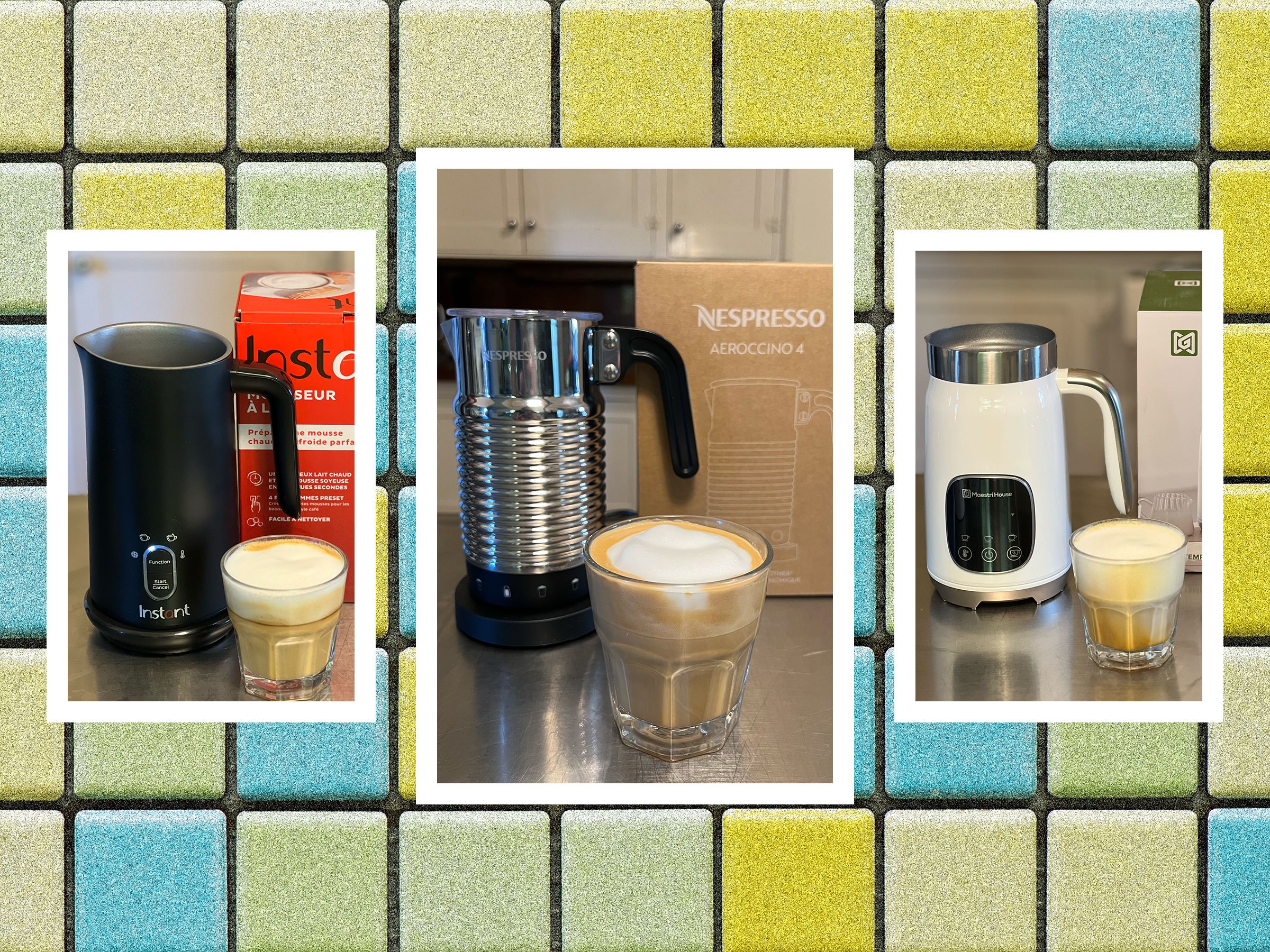If you buy something using links in our stories, we may earn a commission. Learn more.
Best Overall
Subminimal NanoFoamer Pro
Runner-Up
Dreo BaristaMaker
Best Value
Dreo BaristaMaker Milk Frother Air
Best Budget Option
Instant Pot Milk Frother
Cortado. Caffe Latte. Caccionis. Affogato. Hot Wet. Flat White.
Two of those six drinks are fake, but that shouldn’t stop you from ordering one and expecting the barista to nod politely and whip something on the fly to avoid coming off as behind the times. Cafés in touristy regions of Italy began adding milk to coffee to make it more palatable for normies more than three centuries ago, and simple lattes and cappuccinos have been staples at American coffee shops since the late ’80s. Yet the obsession with tinkering and renaming subtle variations on this winning formula scans as a very third-wave development that feels less like innovation and more like beleaguered riffing for riffing’s sake.
The market for electric milk frothers is abuzz. A mechanized pitcher that automatically heats and froths milk is not a new concept, but a recent spate of boutique options that claim they can create the type of microfoam needed to pour latte with little effort is an exciting development. To borrow an aphorism my local barista rattles off daily while pouring flawless rosettas without batting an eye, “Big if true!”
Across the span of five months, I tried out multiple milk frothers to see whether any of them could turn a cup of whole milk into that silky smooth microfoam that glistens under the ceiling lights before you knock it on the counter, swish it around, and pour it over a shot of espresso. This turned out to be a near-impossible task, but a few pleasant surprises—such as Subminimal’s NanoFoamer Pro ($159) and Dreo’s BaristaMaker Milk Frother Air ($60)—gave me hope that a milk frother may one day be an indispensable part of my at-home coffee kit. Nouveau riche cortado junkies won’t find much to love in this list, but Gen Xers who pine for the days of cozy second-wave shops that served foam-heaped cappuccinos in soup bowls while an Ani DiFranco clone sang slam poetry in the corner will be absolutely stoked on almost every item here. Busy moms with a brood of cocoa-slurping kiddos will find a worthy addition to their wish list too, which is not nothing!
To further hone your home espresso artistry, check out our guides to the Best Espresso Machines, Best Latte and Cappuccino Machines, Best Coffee Grinders, and Best Nut Milk Makers.
Updated April 2025: We’ve added the Melitta Montalatte and Dreo BaristaMaker Air and updated links and prices throughout.
Power up with unlimited access to WIRED. Get best-in-class reporting that’s too important to ignore for just $2.50 $1 per month for 1 year. Includes unlimited digital access and exclusive subscriber-only content. Subscribe Today.
With each unit I used 8 ounces of organic whole milk that was pulled from the fridge at 45 degrees Fahrenheit. I did not test any nondairy milks because of the wild variance in fat and sugar content, viscosity, and availability of each. Besides, we’ll probably be done with the hip alternative milk of the hour by the time this is published, rendering my extensive testing with fair-trade bird-safe macadamia milk useless.
I followed the instructions or quick-start guides that materialized after shaking out the box, and aimed for “wet froth” or a “flat white” if the instructions explicitly offered a process oriented toward that outcome. I swooshed the milk around in the frothing pitcher to get a better sense of the froth texture, decanted it, and attempted to pour an 8-ounce cappuccino with latte art. I did this three times with each frother and made note of the average time of its frothing cycle, the final temperature of the milk, and the consistency and texture of the frothed milk.
-
Photograph: Subminimal
Best Overall
Subminimal NanoFoamer Pro
This sleek black pitcher from Subminimal managed to pull off a hat trick of impressive attributes that made it a shoo-in for the best of the best. The aesthetic is simple and understated yet eye-catching and futuristic. The engineering is advanced yet approachable. And the froth produced by the NanoFoamer Pro is perfect for latte art straight out of the pitcher—no need to decant into a steaming pitcher unless you’re adhering to strict scientific guidelines like I was.
The NanoFoamer Pro has a unique frothing system that utilizes a lid-mounted impeller instead of one that’s mounted on the base of the pitcher, leaving a tiny gap in between for increased circulation. Select from a trio of rubber color-coded “flow controls” that stick to the inside of the pitcher with a magnet, with varying thicknesses that control how fast the milk sloshes around them when the unit is turned on. Once the unit is placed on its base it will “wake up,” then you press the black-and-white LED screen to select 1 through 5 for the aeration time.
The laminated quick-start guide suggested the black flow controller (the thickest of the three) and a setting of 2 for wetter froth and a moderate dose size–somewhere between a cappuccino and a latte, based on the icons shown in the guide. I followed the instructions, waited about 3 minutes, and the machine beeped at me and said “OK” on the LED screen. The instructions suggest keeping the pitcher on its base an extra minute or two after you see it say “OK” for a higher temp, but 140 degrees Fahrenheit was exactly what I saw aiming for, so I pulled it off and examined it right away. The result was a remarkably consistent froth that had just enough gradient between wet liquid at the bottom and smooth foam at the top that danced into my cup with a quick twist of the wrist.
The NanoFoamer Pro is now my go-to for velvety-smooth froth on cortados with espresso from the Casabrews 5700 Pro (7/10 WIRED Review), which can’t steam milk and dose espresso at once on account of having only one boiler. Its froth is a nice accent for shots brewed with an old-school stovetop espresso machine as well, which means a budding barista with a minimal budget can use it to get in some reps at home without shelling out hundreds or thousands of dollars for a proper espresso machine.
Minimum capacity: 4 ounces Maximum capacity: 8 ounces Average time and final temperature of cycle: 3:04 to 141ºF -
Photograph: Pete Cottell
Runner-Up
Dreo BaristaMaker
The Dreo BaristaMaker is the Honda Accord of milk frothers. It’s sophisticated and capable, but it’s not byzantine or fussy. It does exactly what it’s supposed to do, and it will do so in an uncomplicated manner that anyone can appreciate. The buttons are simple and predictable. With the exception of the interchangeable impeller tips, there’s little explanation needed to figure out how to use this thing right out of the box. I tried it out without reading the manual to see what would happen, and I got perfectly functional wet foam steamed to 130 degrees Fahrenheit with very little effort. It wasn’t the best, but it certainly wasn’t the worst.
After reviewing the instructions, I figured out I used the wrong impeller in my trial run, so I switched to the tip that looks like an airplane propeller and adjusted my dose of milk accordingly. With a 7.5-ounce minimum capacity, you’re much better off with a larger drink, like a flat white or traditional latte, than a smaller drink like a cappuccino or cortado. The 10-ounce max capacity makes this a flexible option that’s fine for steaming a larger batch of milk that needs heat but very little aeration. The Froth Mode panel on the left has buttons for milk type—dairy, oat, etc.—and different foam options for latte, cappuccino, and so on. The right side has a speed control that’s adjusted to match the tip that’s installed, and the temperature button is adjustable from 130 to 170 degrees Fahrenheit, or cold if you don’t want any heat.
I poured in 8 ounces of whole milk, selected Hot Cappuccino with the Foam button, dialed in 140 degrees Fahrenheit for the temperature, and selected the speed setting that matched the impeller tip rather than the mesh disc. About three and a half minutes later I got a pitcher filled with smooth, wet froth that formed a ring around a clump of dry foam that floated freely at the top of the liquid. It blended together nicely in the steaming pitcher, and a decent attempt at a rose adorning my cappuccino was the final outcome. The 140-degree Fahrenheit setting consistently undershot the desired output temperature, so I’ve been setting it to 150 to account for this one strange quirk.
Minimum capacity: 7.5 ounces Maximum capacity: 10 ounces Average time and final temperature of cycle: 3:41 to 130ºF
-
Photograph:Pete Cottell
Best Value
Dreo BaristaMaker Milk Frother Air
Dreo’s original BaristaMaker, above, received high marks and penultimate status in our first round of tests, with the only serious knock being its larger size that required a minimum of around 7.5 ounces of milk to get good froth for latte art on smaller drinks. The Air is the original’s little brother, with a smaller overall volume (about 16 ounces max, with the highest line for the “Stir” function clocking in at 8 ounces) and a tighter cylindrical shape that’s better suited for smaller drinks.
The menu button toggles between one of six modes, each with its own easy-to-read icon, and the start/stop button fires it up. Tests with the minimum required volume of 6 ounces—clearly marked as “LATTE ART” on the inside of the frothing chamber—yielded an average of three minutes and 20 seconds to create velvety micro-foam that clocked in around 160 degrees Fahrenheit. Similar to the larger unit, the Air uses a sturdy plastic impeller tip for more foam, and a small Slinky-esque coil for drinks that require less aeration, like lattes and hot chocolates. It was incredibly simple to add some milk, pop the pitcher in the base, attach the clear plastic lid, click start, and pull a shot while the Air quietly did its thing. The milk was perfect for latte art on the first try, and it’s consistently some of the best froth for the least effort out of all the frothers we tried. This is an absolute steal at $60—about half that of the world-beating NanoFoamer Pro from Subminimal—and is a fantastic addition to any coffee geek’s arsenal of gadgetry.
Minimum capacity: 4 oz Maximum capacity: 12 oz Average time and final temperature of cycle: 4:10 to 165º -
Photograph: Pete Cottell
Best Budget Option
Instant Pot Milk Frother
Best known for its world-beating, digitally controlled pressure cooker, Instant offers a BS-free milk frother at a reasonable price that won’t leave you feeling bad about buying it on a lark and using it only two or three times a year. This barebones machine has a simple function button that toggles through four options: cold foam, hot with light froth, hot with heavy froth, and hot without froth. The hot ’n’ heavy option yielded a dense glob of smooth, frothy milk with very little liquid at the bottom. A few whacks against the counter settled some bubbles and allowed about 3 ounces of liquid to sneak out of the bottom, and then the fluffy cloud of milk on top slid on top of the beverage in pillowy waves.
Minimum capacity: 4 ounces Maximum capacity: 9 ounces Average time and final temperature of cycle: 2:01 to 150ºF
-
Photograoh: Pete Cottell
Best for Everything but Latte Art
Breville Milk Cafe Frother BMF600XL
The massive 18-ounce capacity for this absolute unit of a device is its biggest upside, while its inability to make decent froth for a smaller drink that would enjoy a nice heart or leaf on top is its greatest downside. The controls are simple, with a large dial on the front that sets your target temperature and a start/stop button nested inside the dial. Eight ounces of dairy milk with the dial set to the high end of the black stripe labeled 140 degrees Fahrenheit nearly doubled the volume of the input in under two minutes, yielding a glorious mountain of goopy froth you can heap on top of your drink with a spoon. This is wholly incompatible with modern latte art, but the current trend of Gen Z pining for the ’90s as it was represented in Friends could lead the coffee world to a place where 16-ounce “cappuccinos” piled high with pliant, pillory froth is considered “art” again.
If all you care about is heating milk in bulk without babysitting a boiling pot or rolling the dice on picking a time at random in a microwave and hoping for the best, then the Breville BMF600XL should be at the top of your list. Busy moms who want a hassle-free device that cranks out pints of hot chocolate in just a couple of minutes will consider this a kitchen staple, and anyone who misses the days when Hush Puppies shoes, baggy oxford shirts from The Gap, and stonewashed Levi’s 501 jeans were wardrobe staples will love the old-school feel of the froth this thing cranks out with ease.
Minimum capacity: 6 ounces Maximum capacity: 18 ounces Average time and final temperature of cycle: 1:55 to 136ºF -
Photograph: Amazon
If You Don’t Mind Cold Foam Only
Zulay Kitchen Milk Frother Wand
Clocking at under $10, this dinky little battery-powered mixing wand bills itself as a “milk frother,” so we had to include it. It doesn’t heat your milk, but it’s a tad more efficient than using a straw to blow bubbles in it like a child, so it’s good for that at the very least. Cold froth is an acquired taste I have little interest in, but I have worked with a handful of baristas over the years who would sneak these things in and use them to make cold foam for knockoff Starbucks drinks, iced matcha lattes, or the scoop of magical powder their favorite YouTuber told them to purchase to “increase focus and virility” when they could just stop staying out until 4 am every night and achieve more tangible results.
Minimum capacity: N/A Maximum capacity: N/A Average time and final temperature of cycle: N/A
-
Photograph: Pete Cottell
Honorable Mention
Nespresso Aeroccino 4 Refresh
This funky little metallic tube is a dynamo at steaming small amounts of milk with maximum efficiency and minimal fuss. Pour in 8 ounces of milk, which is the recommended maximum for the unit, then pop it on the base and choose one of four modes: cold froth, hot with no froth, hot with light froth, and hot with heavy froth. About 1:45 later I got a thick glob of foam haloed by wet milk that hit around 150 degrees Fahrenheit, which is by far the fastest of the various units we tried out. The foam was too dense and immovable to blend with the wet milk, yielding very little gradient between liquid and foam for the sake of latte art. The end result was the type of cappuccino that’s good for three to four sips until the foam cools off, dries out, and clings to the edges of the glass in a bubbly, tan crust. Considering the flexibility offered by units nearly half the price this is not a great option, but it gets the job done and is worth keeping if it shows up on the gift table at a wedding or shower.
Minimum capacity: Not marked Maximum capacity: 4 ounces for foam, 8 ounces for wet milk Average time and final temperature of cycle: 1:43 to 150ºF
Honorable Mentions
Melitta Montalatte Milk Frother for $100: We’ll forgive you if you have no idea Melitta made any notable contributions to the coffee space aside from the filters every coffee drinker buys once they’ve graduated from a “whatever’s in the pot” guy to a “my coffee-making experience is a ritual” guy. Melitta has quietly been plugging away in the coffee gear space for some time now, and its new Montalatte Milk Frother lands in the same tier as many of its other gadgets. It’s easy to use, it gets the job done without knocking your socks off, and it won’t break the bank. One notable design flaw is the weakness of the magnet that keeps the agitator attached to the base of the pitcher. You’ll need to remove it fully before attempting to pour, which can mess with the foam you’ve been building once the frothing process is finished. It’s easy to correct if you prefer to decant the liquid into a proper frothing pitcher and smack it around a few times there for good measure, but it took me by surprise the first time and almost made quite a mess.
Photograph: Pete Cottell
Maestri House Electric Milk Frother for $70: The marketing copy on the Maestri House website associated with its electric milk frother reads “Barista Finesse of Temperature and Thickness,” so it’s safe to assume this is yet another weird Amazon brand that always shows up alongside brands you’ve actually heard of when you search for gadgets. The manual told me to select medium foam, 150 degrees Fahrenheit, and 30 percent thickness for a cappuccino, so I fired it up and hoped for the best. There was quite a bit of separation between the liquid at the bottom and the dry froth at the top, which was best suited for a more classic style of cappuccino that’s equal parts espresso, wet milk, and dry froth at the top. No amount of banging the steaming pitcher on the counter or sloshing around the liquid would merge the dry froth with the liquid, so latte art was out of the question. The clump of dry foam on the top of my drink was pleasant for a few sips, and it reminded me of a simpler time when lattes and cappuccinos were the only drinks available that melded espresso with frothed milk. At any rate, this is a reliable frother with a simple interface and predictable results at a decent price.
Not Recommended
Bodum Barista Electric Milk Frother for $60: Bodum makes lots of gear at all sorts of price points, and the same-y design of many of its items makes it difficult to figure out which is which and why you should spend the extra cash for a unit that looks almost identical to a cheaper option with a similar name. On the first and third tests with the maximum 8-ounce dose of whole milk, it sputtered out of control and overflowed about three minutes into its excessively long five-minute cycle. I checked the instructions to make sure I wasn’t doing anything wrong, which revealed this unit should be essentially idiot-proof in its options. There’s a single button you press once for hot froth, twice for hot chocolate (no frothing action), and three times for cold froth. This should be impossible to screw up, yet there I was with a hot, white liquid oozing out of the lid and running down the sides of the machine and onto the counter. When I finally got a good run out of the machine, it yielded layer upon layer of gooey 160-degree Fahrenheit foam that could almost be folded over like a French omelet. It was nearly burnt and smelled like bread pudding. This is not a frother I would recommend to anyone under any circumstance.




